SIBT BUSS150 Management Fundamentals: Analyzing FireArt Incorporation
VerifiedAdded on 2023/05/29
|5
|1536
|321
Case Study
AI Summary
This case study analyzes FireArt Incorporation, focusing on the leadership challenges faced by Eric Holt and the dysfunctional team dynamics involving stakeholders like Randy Louderback, Jack Derry, and others. The issues include non-collaboration, poor communication, and lack of appreciation, leading to a negative working environment. The analysis suggests implementing management theories such as chaos theory, competition concept, and stakeholder theory to address these challenges. Recommended strategies include improved collaboration, enhanced communication, employee training, fair treatment, and a shift from traditional hierarchical structures to a modern administrative approach. The proposed execution involves regular engagement from leadership, team-building workshops, and strategic planning to foster a supportive corporate culture and improve overall team effectiveness. The study emphasizes the importance of clear goals, understanding team dynamics, and maximizing individual competences for organizational success.
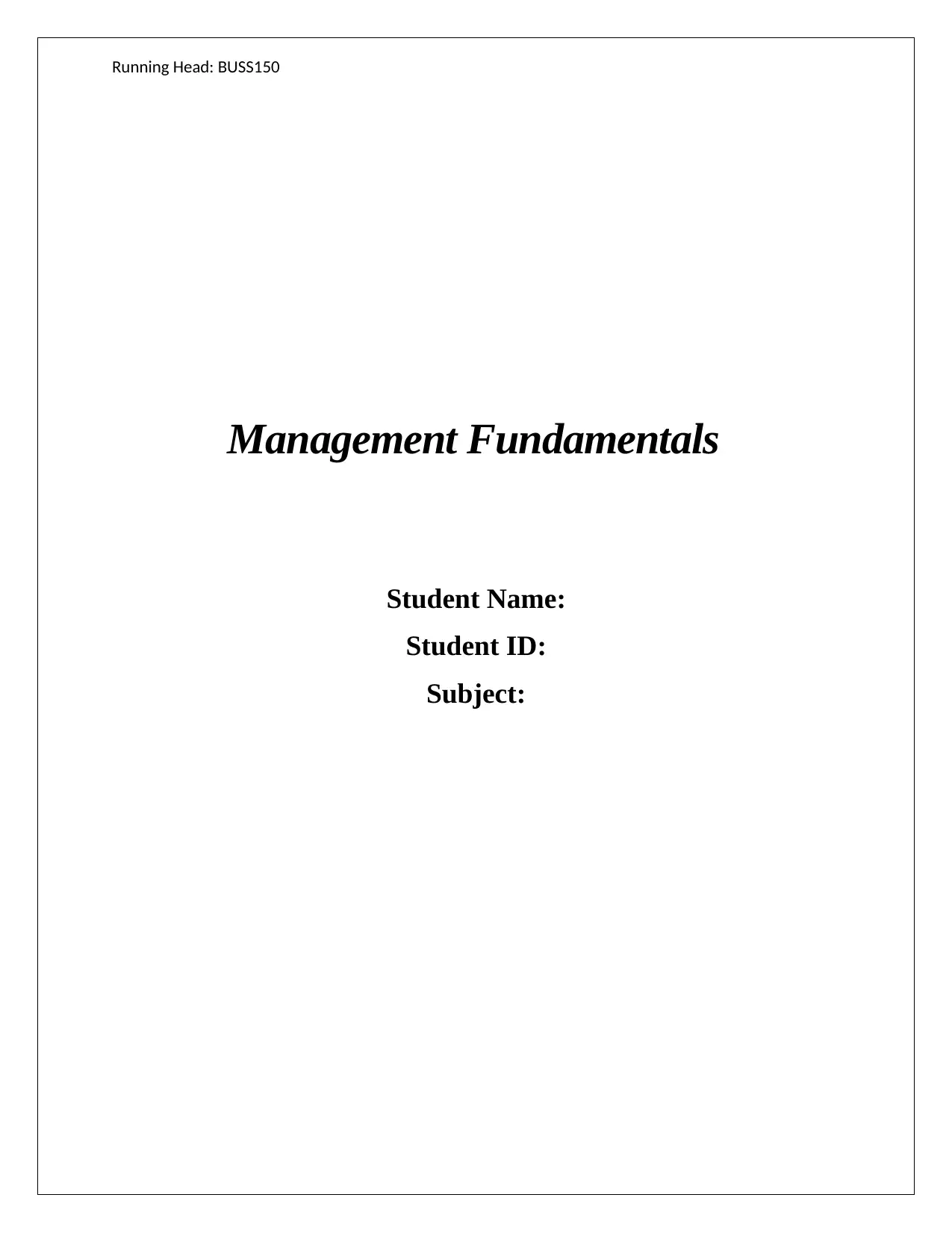
Running Head: BUSS150
Management Fundamentals
Student Name:
Student ID:
Subject:
Management Fundamentals
Student Name:
Student ID:
Subject:
Paraphrase This Document
Need a fresh take? Get an instant paraphrase of this document with our AI Paraphraser
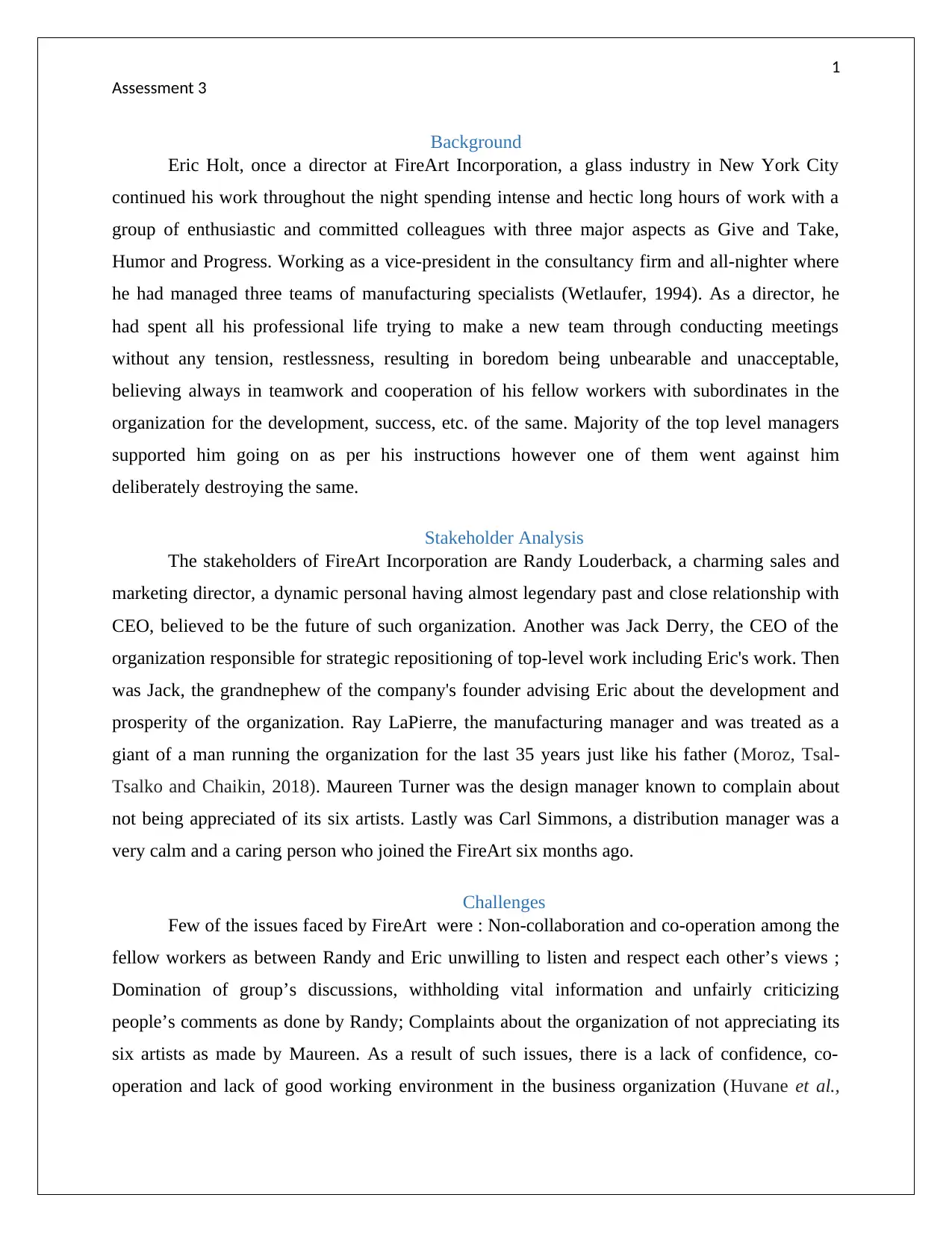
1
Assessment 3
Background
Eric Holt, once a director at FireArt Incorporation, a glass industry in New York City
continued his work throughout the night spending intense and hectic long hours of work with a
group of enthusiastic and committed colleagues with three major aspects as Give and Take,
Humor and Progress. Working as a vice-president in the consultancy firm and all-nighter where
he had managed three teams of manufacturing specialists (Wetlaufer, 1994). As a director, he
had spent all his professional life trying to make a new team through conducting meetings
without any tension, restlessness, resulting in boredom being unbearable and unacceptable,
believing always in teamwork and cooperation of his fellow workers with subordinates in the
organization for the development, success, etc. of the same. Majority of the top level managers
supported him going on as per his instructions however one of them went against him
deliberately destroying the same.
Stakeholder Analysis
The stakeholders of FireArt Incorporation are Randy Louderback, a charming sales and
marketing director, a dynamic personal having almost legendary past and close relationship with
CEO, believed to be the future of such organization. Another was Jack Derry, the CEO of the
organization responsible for strategic repositioning of top-level work including Eric's work. Then
was Jack, the grandnephew of the company's founder advising Eric about the development and
prosperity of the organization. Ray LaPierre, the manufacturing manager and was treated as a
giant of a man running the organization for the last 35 years just like his father (Moroz, Tsal-
Tsalko and Chaikin, 2018). Maureen Turner was the design manager known to complain about
not being appreciated of its six artists. Lastly was Carl Simmons, a distribution manager was a
very calm and a caring person who joined the FireArt six months ago.
Challenges
Few of the issues faced by FireArt were : Non-collaboration and co-operation among the
fellow workers as between Randy and Eric unwilling to listen and respect each other’s views ;
Domination of group’s discussions, withholding vital information and unfairly criticizing
people’s comments as done by Randy; Complaints about the organization of not appreciating its
six artists as made by Maureen. As a result of such issues, there is a lack of confidence, co-
operation and lack of good working environment in the business organization (Huvane et al.,
Assessment 3
Background
Eric Holt, once a director at FireArt Incorporation, a glass industry in New York City
continued his work throughout the night spending intense and hectic long hours of work with a
group of enthusiastic and committed colleagues with three major aspects as Give and Take,
Humor and Progress. Working as a vice-president in the consultancy firm and all-nighter where
he had managed three teams of manufacturing specialists (Wetlaufer, 1994). As a director, he
had spent all his professional life trying to make a new team through conducting meetings
without any tension, restlessness, resulting in boredom being unbearable and unacceptable,
believing always in teamwork and cooperation of his fellow workers with subordinates in the
organization for the development, success, etc. of the same. Majority of the top level managers
supported him going on as per his instructions however one of them went against him
deliberately destroying the same.
Stakeholder Analysis
The stakeholders of FireArt Incorporation are Randy Louderback, a charming sales and
marketing director, a dynamic personal having almost legendary past and close relationship with
CEO, believed to be the future of such organization. Another was Jack Derry, the CEO of the
organization responsible for strategic repositioning of top-level work including Eric's work. Then
was Jack, the grandnephew of the company's founder advising Eric about the development and
prosperity of the organization. Ray LaPierre, the manufacturing manager and was treated as a
giant of a man running the organization for the last 35 years just like his father (Moroz, Tsal-
Tsalko and Chaikin, 2018). Maureen Turner was the design manager known to complain about
not being appreciated of its six artists. Lastly was Carl Simmons, a distribution manager was a
very calm and a caring person who joined the FireArt six months ago.
Challenges
Few of the issues faced by FireArt were : Non-collaboration and co-operation among the
fellow workers as between Randy and Eric unwilling to listen and respect each other’s views ;
Domination of group’s discussions, withholding vital information and unfairly criticizing
people’s comments as done by Randy; Complaints about the organization of not appreciating its
six artists as made by Maureen. As a result of such issues, there is a lack of confidence, co-
operation and lack of good working environment in the business organization (Huvane et al.,
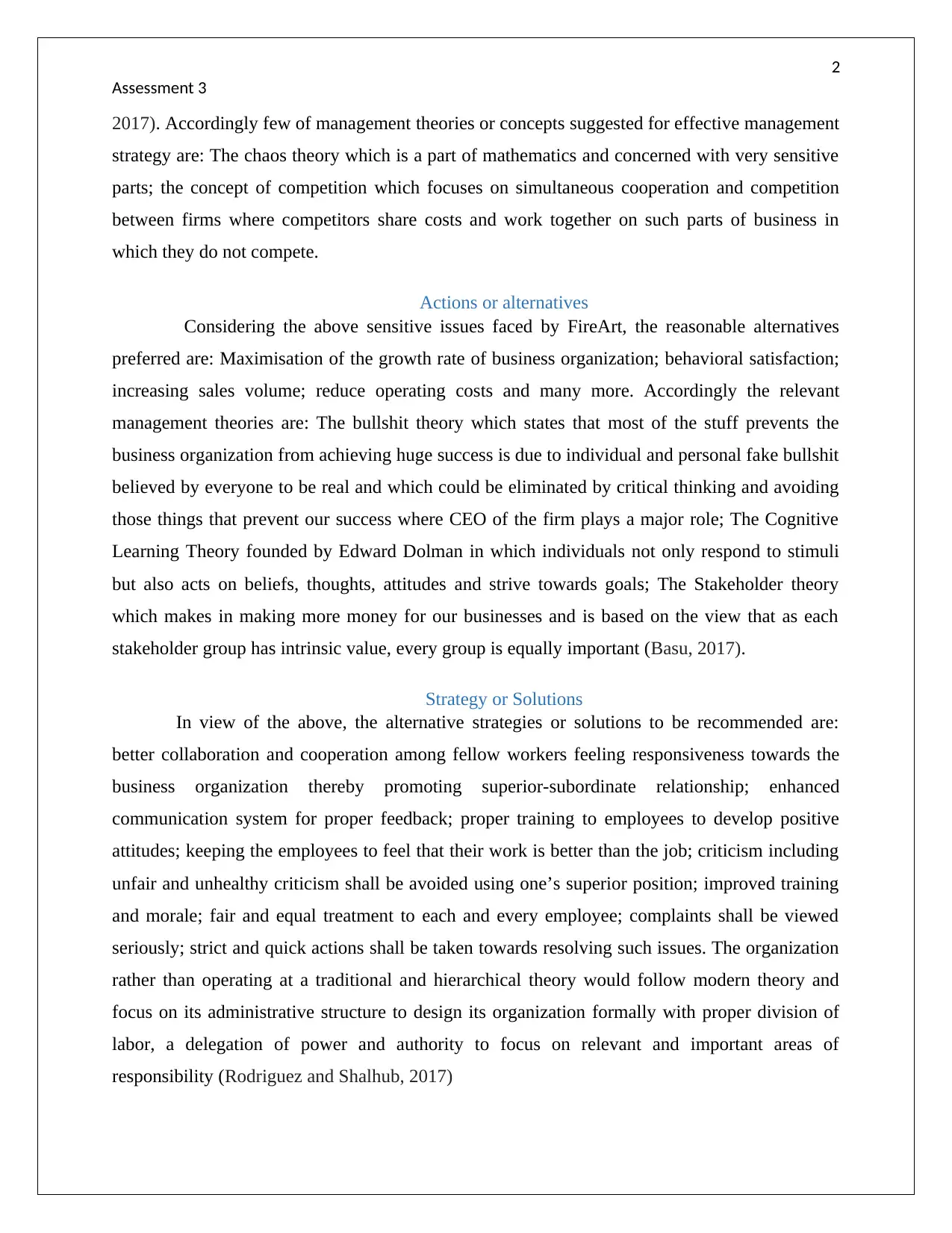
2
Assessment 3
2017). Accordingly few of management theories or concepts suggested for effective management
strategy are: The chaos theory which is a part of mathematics and concerned with very sensitive
parts; the concept of competition which focuses on simultaneous cooperation and competition
between firms where competitors share costs and work together on such parts of business in
which they do not compete.
Actions or alternatives
Considering the above sensitive issues faced by FireArt, the reasonable alternatives
preferred are: Maximisation of the growth rate of business organization; behavioral satisfaction;
increasing sales volume; reduce operating costs and many more. Accordingly the relevant
management theories are: The bullshit theory which states that most of the stuff prevents the
business organization from achieving huge success is due to individual and personal fake bullshit
believed by everyone to be real and which could be eliminated by critical thinking and avoiding
those things that prevent our success where CEO of the firm plays a major role; The Cognitive
Learning Theory founded by Edward Dolman in which individuals not only respond to stimuli
but also acts on beliefs, thoughts, attitudes and strive towards goals; The Stakeholder theory
which makes in making more money for our businesses and is based on the view that as each
stakeholder group has intrinsic value, every group is equally important (Basu, 2017).
Strategy or Solutions
In view of the above, the alternative strategies or solutions to be recommended are:
better collaboration and cooperation among fellow workers feeling responsiveness towards the
business organization thereby promoting superior-subordinate relationship; enhanced
communication system for proper feedback; proper training to employees to develop positive
attitudes; keeping the employees to feel that their work is better than the job; criticism including
unfair and unhealthy criticism shall be avoided using one’s superior position; improved training
and morale; fair and equal treatment to each and every employee; complaints shall be viewed
seriously; strict and quick actions shall be taken towards resolving such issues. The organization
rather than operating at a traditional and hierarchical theory would follow modern theory and
focus on its administrative structure to design its organization formally with proper division of
labor, a delegation of power and authority to focus on relevant and important areas of
responsibility (Rodriguez and Shalhub, 2017)
Assessment 3
2017). Accordingly few of management theories or concepts suggested for effective management
strategy are: The chaos theory which is a part of mathematics and concerned with very sensitive
parts; the concept of competition which focuses on simultaneous cooperation and competition
between firms where competitors share costs and work together on such parts of business in
which they do not compete.
Actions or alternatives
Considering the above sensitive issues faced by FireArt, the reasonable alternatives
preferred are: Maximisation of the growth rate of business organization; behavioral satisfaction;
increasing sales volume; reduce operating costs and many more. Accordingly the relevant
management theories are: The bullshit theory which states that most of the stuff prevents the
business organization from achieving huge success is due to individual and personal fake bullshit
believed by everyone to be real and which could be eliminated by critical thinking and avoiding
those things that prevent our success where CEO of the firm plays a major role; The Cognitive
Learning Theory founded by Edward Dolman in which individuals not only respond to stimuli
but also acts on beliefs, thoughts, attitudes and strive towards goals; The Stakeholder theory
which makes in making more money for our businesses and is based on the view that as each
stakeholder group has intrinsic value, every group is equally important (Basu, 2017).
Strategy or Solutions
In view of the above, the alternative strategies or solutions to be recommended are:
better collaboration and cooperation among fellow workers feeling responsiveness towards the
business organization thereby promoting superior-subordinate relationship; enhanced
communication system for proper feedback; proper training to employees to develop positive
attitudes; keeping the employees to feel that their work is better than the job; criticism including
unfair and unhealthy criticism shall be avoided using one’s superior position; improved training
and morale; fair and equal treatment to each and every employee; complaints shall be viewed
seriously; strict and quick actions shall be taken towards resolving such issues. The organization
rather than operating at a traditional and hierarchical theory would follow modern theory and
focus on its administrative structure to design its organization formally with proper division of
labor, a delegation of power and authority to focus on relevant and important areas of
responsibility (Rodriguez and Shalhub, 2017)
⊘ This is a preview!⊘
Do you want full access?
Subscribe today to unlock all pages.

Trusted by 1+ million students worldwide
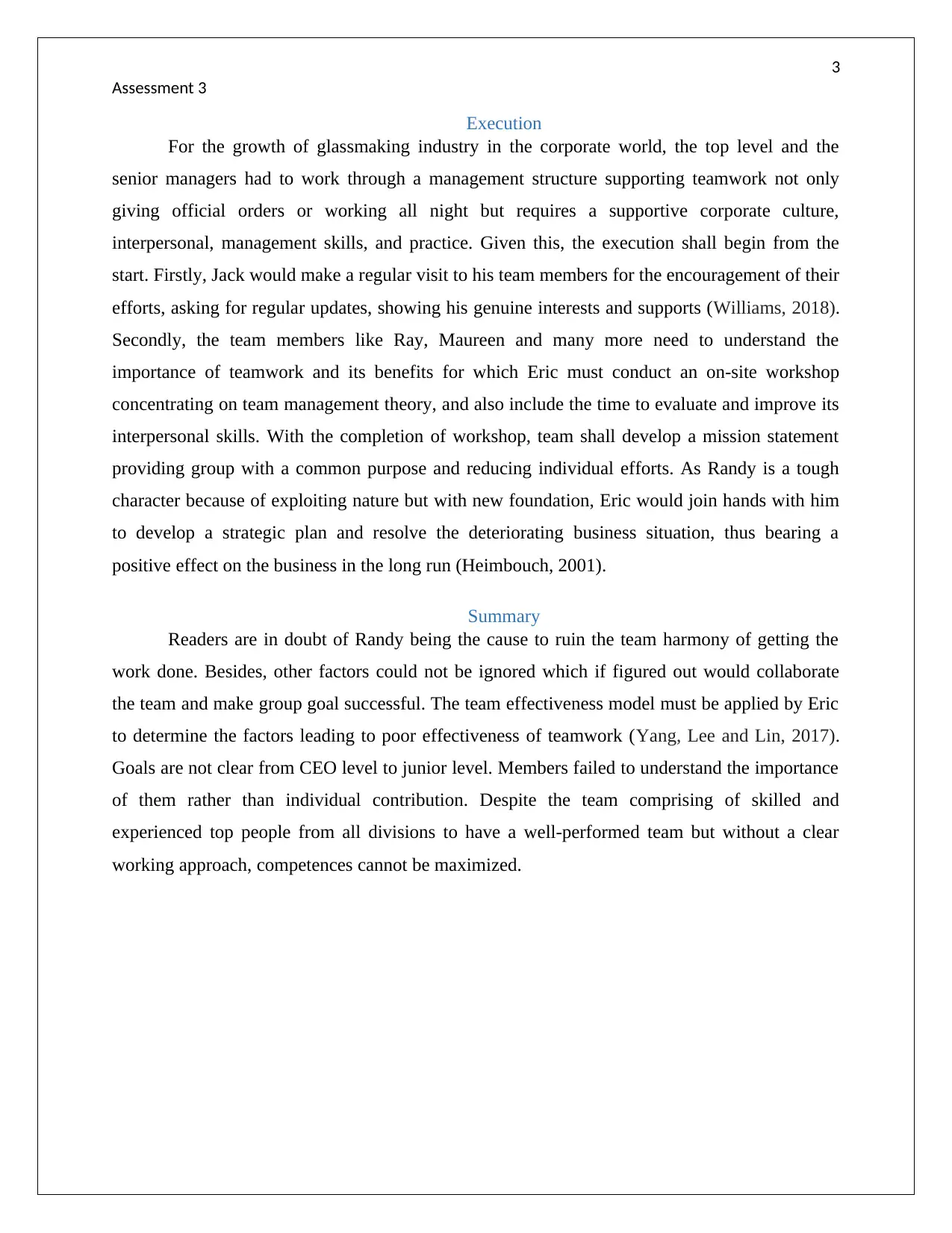
3
Assessment 3
Execution
For the growth of glassmaking industry in the corporate world, the top level and the
senior managers had to work through a management structure supporting teamwork not only
giving official orders or working all night but requires a supportive corporate culture,
interpersonal, management skills, and practice. Given this, the execution shall begin from the
start. Firstly, Jack would make a regular visit to his team members for the encouragement of their
efforts, asking for regular updates, showing his genuine interests and supports (Williams, 2018).
Secondly, the team members like Ray, Maureen and many more need to understand the
importance of teamwork and its benefits for which Eric must conduct an on-site workshop
concentrating on team management theory, and also include the time to evaluate and improve its
interpersonal skills. With the completion of workshop, team shall develop a mission statement
providing group with a common purpose and reducing individual efforts. As Randy is a tough
character because of exploiting nature but with new foundation, Eric would join hands with him
to develop a strategic plan and resolve the deteriorating business situation, thus bearing a
positive effect on the business in the long run (Heimbouch, 2001).
Summary
Readers are in doubt of Randy being the cause to ruin the team harmony of getting the
work done. Besides, other factors could not be ignored which if figured out would collaborate
the team and make group goal successful. The team effectiveness model must be applied by Eric
to determine the factors leading to poor effectiveness of teamwork (Yang, Lee and Lin, 2017).
Goals are not clear from CEO level to junior level. Members failed to understand the importance
of them rather than individual contribution. Despite the team comprising of skilled and
experienced top people from all divisions to have a well-performed team but without a clear
working approach, competences cannot be maximized.
Assessment 3
Execution
For the growth of glassmaking industry in the corporate world, the top level and the
senior managers had to work through a management structure supporting teamwork not only
giving official orders or working all night but requires a supportive corporate culture,
interpersonal, management skills, and practice. Given this, the execution shall begin from the
start. Firstly, Jack would make a regular visit to his team members for the encouragement of their
efforts, asking for regular updates, showing his genuine interests and supports (Williams, 2018).
Secondly, the team members like Ray, Maureen and many more need to understand the
importance of teamwork and its benefits for which Eric must conduct an on-site workshop
concentrating on team management theory, and also include the time to evaluate and improve its
interpersonal skills. With the completion of workshop, team shall develop a mission statement
providing group with a common purpose and reducing individual efforts. As Randy is a tough
character because of exploiting nature but with new foundation, Eric would join hands with him
to develop a strategic plan and resolve the deteriorating business situation, thus bearing a
positive effect on the business in the long run (Heimbouch, 2001).
Summary
Readers are in doubt of Randy being the cause to ruin the team harmony of getting the
work done. Besides, other factors could not be ignored which if figured out would collaborate
the team and make group goal successful. The team effectiveness model must be applied by Eric
to determine the factors leading to poor effectiveness of teamwork (Yang, Lee and Lin, 2017).
Goals are not clear from CEO level to junior level. Members failed to understand the importance
of them rather than individual contribution. Despite the team comprising of skilled and
experienced top people from all divisions to have a well-performed team but without a clear
working approach, competences cannot be maximized.
Paraphrase This Document
Need a fresh take? Get an instant paraphrase of this document with our AI Paraphraser
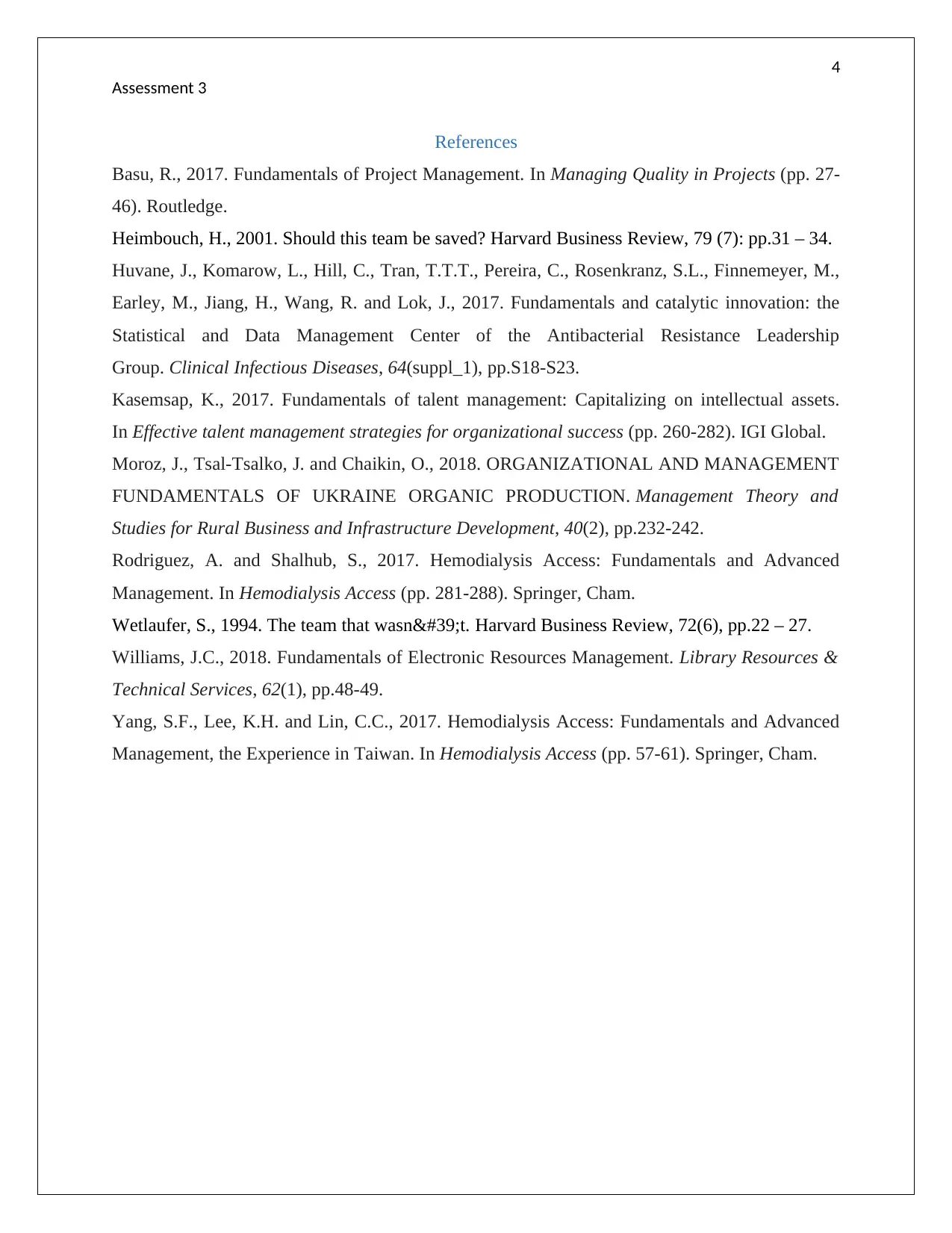
4
Assessment 3
References
Basu, R., 2017. Fundamentals of Project Management. In Managing Quality in Projects (pp. 27-
46). Routledge.
Heimbouch, H., 2001. Should this team be saved? Harvard Business Review, 79 (7): pp.31 – 34.
Huvane, J., Komarow, L., Hill, C., Tran, T.T.T., Pereira, C., Rosenkranz, S.L., Finnemeyer, M.,
Earley, M., Jiang, H., Wang, R. and Lok, J., 2017. Fundamentals and catalytic innovation: the
Statistical and Data Management Center of the Antibacterial Resistance Leadership
Group. Clinical Infectious Diseases, 64(suppl_1), pp.S18-S23.
Kasemsap, K., 2017. Fundamentals of talent management: Capitalizing on intellectual assets.
In Effective talent management strategies for organizational success (pp. 260-282). IGI Global.
Moroz, J., Tsal-Tsalko, J. and Chaikin, O., 2018. ORGANIZATIONAL AND MANAGEMENT
FUNDAMENTALS OF UKRAINE ORGANIC PRODUCTION. Management Theory and
Studies for Rural Business and Infrastructure Development, 40(2), pp.232-242.
Rodriguez, A. and Shalhub, S., 2017. Hemodialysis Access: Fundamentals and Advanced
Management. In Hemodialysis Access (pp. 281-288). Springer, Cham.
Wetlaufer, S., 1994. The team that wasn't. Harvard Business Review, 72(6), pp.22 – 27.
Williams, J.C., 2018. Fundamentals of Electronic Resources Management. Library Resources &
Technical Services, 62(1), pp.48-49.
Yang, S.F., Lee, K.H. and Lin, C.C., 2017. Hemodialysis Access: Fundamentals and Advanced
Management, the Experience in Taiwan. In Hemodialysis Access (pp. 57-61). Springer, Cham.
Assessment 3
References
Basu, R., 2017. Fundamentals of Project Management. In Managing Quality in Projects (pp. 27-
46). Routledge.
Heimbouch, H., 2001. Should this team be saved? Harvard Business Review, 79 (7): pp.31 – 34.
Huvane, J., Komarow, L., Hill, C., Tran, T.T.T., Pereira, C., Rosenkranz, S.L., Finnemeyer, M.,
Earley, M., Jiang, H., Wang, R. and Lok, J., 2017. Fundamentals and catalytic innovation: the
Statistical and Data Management Center of the Antibacterial Resistance Leadership
Group. Clinical Infectious Diseases, 64(suppl_1), pp.S18-S23.
Kasemsap, K., 2017. Fundamentals of talent management: Capitalizing on intellectual assets.
In Effective talent management strategies for organizational success (pp. 260-282). IGI Global.
Moroz, J., Tsal-Tsalko, J. and Chaikin, O., 2018. ORGANIZATIONAL AND MANAGEMENT
FUNDAMENTALS OF UKRAINE ORGANIC PRODUCTION. Management Theory and
Studies for Rural Business and Infrastructure Development, 40(2), pp.232-242.
Rodriguez, A. and Shalhub, S., 2017. Hemodialysis Access: Fundamentals and Advanced
Management. In Hemodialysis Access (pp. 281-288). Springer, Cham.
Wetlaufer, S., 1994. The team that wasn't. Harvard Business Review, 72(6), pp.22 – 27.
Williams, J.C., 2018. Fundamentals of Electronic Resources Management. Library Resources &
Technical Services, 62(1), pp.48-49.
Yang, S.F., Lee, K.H. and Lin, C.C., 2017. Hemodialysis Access: Fundamentals and Advanced
Management, the Experience in Taiwan. In Hemodialysis Access (pp. 57-61). Springer, Cham.
1 out of 5
Your All-in-One AI-Powered Toolkit for Academic Success.
+13062052269
info@desklib.com
Available 24*7 on WhatsApp / Email
![[object Object]](/_next/static/media/star-bottom.7253800d.svg)
Unlock your academic potential
Copyright © 2020–2025 A2Z Services. All Rights Reserved. Developed and managed by ZUCOL.
